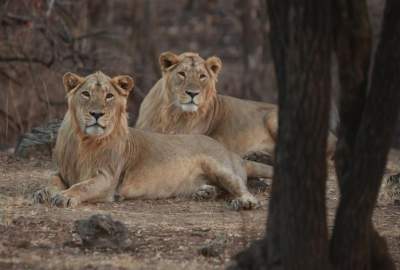Jaipur (IANS) A few years back, there were discussions on relocating the Asiatic lions from Gir Forest in Gujarat to some other states in India because their numbers have outgrown the available forest cover.
But Gir’s lions seem to have lost out to the cheetahs from Namibia who have been settled at the spot where they were supposed to have been relocated — the Kuno national park in Madhya Pradesh.
Cheetah politics, meanwhile, has become the hot subject of discussion in three states, namely, Gujarat, MP and Rajasthan.
It started in Gujarat three decades back as the Centre sought the views of some state governments on how to relocate the Asiatic lions from the Gir Reserve to other national parks in the country.
The reason was to hedge the risk to the lions, whose numbers are growing rapidly, from becoming victims of human-animal conflicts, or being wiped out by a major natural calamity.
It did not make sense to have all the lions in the country located at just one place. The lions needed to be relocated to other appropriate habitats for their own good.
Madhya Pradesh and Rajasthan took the lead and identified several alternate habitats suitable for the Gir lions. Kuno Palpur Sanctuary in MP was adjudged the most ideal forest to become a second home for lions in India.
But Gujarat continued to resist the logical move of relocating the lions, considering it would lose its monopoly over the big cat. In April 2013, the Supreme Court ordered Gujarat to send a few Gir lions to Madhya Pradesh to establish a second population.
The court gave the wildlife authorities six months to complete the transfer. Kuno was upgraded to the status of a National Park and its protected area was increased. About 1,650 inhabitants of 24 villages were resettled outside the protected area. An area of 924 sq km, surrounding the wildlife sanctuary, was added as a buffer zone to human settlements.
Hopes were kept alive of the lions reaching Kuno. But political thinking underwent changes. Then Union Environment Minister, Jairam Ramesh, saw new mileage in the cheetahs who had become extinct in India in the early fifties, so it was decided to bring them from an African country. In 2009, Kuno was proposed as a possible site for the cheetahs’ reintroduction in India.
Their arrival took a long time. Eight cheetahs reached Kuno in mid September 2022 after being airlifted from Namibia. India hailed it as an addition of a wild cat species that had become extinct some seventy years ago!
The call for lions has not remained unheard. Gujarat’s pride was to be maintained – for lions as well. So during January 2022, the Union government drafted a 25-year plan for lions to be relocated within Gujarat state and not in other states. It is on record that the Gujarat government did not carry out the Supreme Court’s order since 2013. It has been resisting the relocation of lions outside Gujarat. According to Bhopal-based environmentalist Ajay Dubey, plans to reintroduce African cheetahs in Kuno National Park is another way to stall the transfer of lions to Kuno National Park.
Talking about the cheetahs at Kuno, officials said, “They are still within the quarantine zone. It is a large open grassland habitat fenced on all sides where the overseas guests roam around. They hunt Spotted Deer which are released within their precincts and are able to catch them,” said an official at Kuno on condition of remaining incognito. They will enjoy the luxury of such spoon feeding for another couple of months. It is to enable them to acclimatize with the local ecological factors. After that they will be let loose in the open fields of Kuno to roam wherever they like, hunt their prey and start a new life in the wilderness of India.
Lauri Marker, founder of the Cheetah Conservation Foundation in Namibia, conveyed to her Indian counterparts: We have done our job from Namibia. If you need more cheetahs, they will be offered. Try South Africa and other neighbouring countries to get more cheetahs.
Marker was the one who flew to Gwalior in a specially designed aircraft carrying the cheetahs for Kuno. She has been to India several times over the past two decades to negotiate the cheetahs’ entry into India. She is now happy that her objective has been fulfilled.
Meanwhile officials confirmed that by the time the present lot of eight cheetahs resume their normal life in Kuno’s wilderness, a new momentum for importing more cheetahs from Africa will start gathering speed. The Union Environment Ministry has an action plan to introduce 50 more cheetahs in India in the next five years. Not all will be billed for Kuno. So where else?
Since Prime Minister Narendra Modi himself introduced the imported wild cats at Kuno on his birthday, a new element in the nation’s polity appears to be gaining currency: Cheetah politics. The states may put in requests for cheetahs in the next reintroduction drive. Madhya Pradesh’s quota appears full through Kuno. Next in the race is Rajasthan which missed the bus this time. Its Mukundara Reserve was selected as an ideal grassland habitat. Lauri Marker visited it in July 2022. Will it receive some cheetahs in the next reintroduction drive of the Union Government?
The cheetah controversy has not died down so far. Eight scientists of international stature have criticised the Union Government over cheetahs having been imported from Namibia. Arjun M. Gopalaswamy, Femke Broekhuis, Leili Khalatbari, Michael G. L. Mills, Ravi Chellam, David Thuo, Abi Tamim Vanak and K. Ullas Karanth, have said that India’s plan is based on three unsubstantiated claims — that cheetahs have run out of space in Africa; that India currently has sufficient and suitable space for them; and that conservation translocations have been successful in wild cheetah range restoration efforts.
They have written an article “Introducing African cheetahs to India is an ill-advised conservation attempt”, published in Nature Ecology and Evolution, to highlight that there are “unknown ecological, disease-related and genetic risks involved in replacing Asiatic cheetahs with the larger cheetahs from southern Africa.” They added: “The action plan appears to have substantially overestimated cheetah carrying capacity in the first release site (Kuno National Park), which is unfenced, harbouring about 500 feral cattle and surrounded by a forested landscape with 169 human settlements. Neither Kuno nor the other landscapes considered are of the size and quality to permit self-sustaining and genetically viable cheetah populations.”
Political pundits said the central government will like to use the cheetahs as a new politico-wilderness model to woo the people and try to receive greater voter support. Let the lions remain at Gir, cheetahs are the new ploy.

